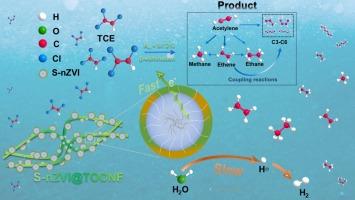当前位置:
X-MOL 学术
›
Chem. Eng. J.
›
论文详情
Our official English website, www.x-mol.net, welcomes your
feedback! (Note: you will need to create a separate account there.)
A Kirkendall strategy for the efficient degradation of trichloroethylene from groundwater using cellulose nanofiber-supported sulfidated nZVI
Chemical Engineering Journal ( IF 13.3 ) Pub Date : 2024-11-19 , DOI: 10.1016/j.cej.2024.157816 Mingda Che, Jingzhe Xiao, Shuya Zhang, Cancan Shan, Ze Zhao, Renliang Huang, Yitong Zhou, Mei Cui, Wei Qi, Rongxin Su
Chemical Engineering Journal ( IF 13.3 ) Pub Date : 2024-11-19 , DOI: 10.1016/j.cej.2024.157816 Mingda Che, Jingzhe Xiao, Shuya Zhang, Cancan Shan, Ze Zhao, Renliang Huang, Yitong Zhou, Mei Cui, Wei Qi, Rongxin Su

|
Nanoscale zero-valent iron (nZVI) is a promising reductant for the degradation of chlorinated hydrocarbons in contaminated groundwater. However, the inherent iron oxide shell limits its dechlorination reactivity. Here, a preparation strategy was proposed to enhance the Kirkendall effect of nZVI, aiming to alleviate the diffusion limitation of Fe atoms. Specifically, sulfidation and cellulose nanofibers (CNF) were employed to alter the shell composition, inducing radial nanocrack formation on S-nZVI@CNF. The type and content of surface groups on CNF are crucial to the nanocrack density, which in turn influences the number of dechlorination sites on S-nZVI@CNF. For the degradation of trichloroethylene (TCE) using carboxylated CNF-modified S-nZVI (S-nZVI@TOCNF), the radial nanocracks enhance its electron-donating capacity, while sulfidation suppresses the side reaction of H2 evolution. Compared with nZVI, S-nZVI@TOCNF demonstrates higher dechlorination reactivity (km = 0.0098 L.g−1.min−1) and selectivity (εe = 19.6 %), thereby accelerating TCE degradation through the β-elimination pathway. Additionally, S-nZVI@TOCNF shows resistance to interference, adaptability across a wide pH range (3.0–11.0), recyclability, and stability. Notably, 92.2 % of TCE from real groundwater was removed. This study employed a Kirkendall strategy to achieve the precise customization of nZVI with varied dechlorination capabilities, enhancing its potential for chlorinated hydrocarbon remediation in groundwater.
中文翻译:

使用纤维素纳米纤维负载的硫化 nZVI 从地下水中高效降解三氯乙烯的 Kirkendall 策略
纳米级零价铁 (nZVI) 是一种很有前途的还原剂,可用于降解受污染地下水中中的氯化烃。然而,固有的氧化铁外壳限制了其脱氯反应性。本文提出了一种增强 nZVI 的 Kirkendall 效应的制备策略,旨在减轻 Fe 原子的扩散限制。具体来说,硫化和纤维素纳米纤维 (CNF) 被用来改变壳组成,诱导在 S-nZVI@CNF 上形成径向纳米裂纹。CNF 上表面基团的类型和含量对纳米裂纹密度至关重要,而纳米裂纹密度又会影响 S-nZVI@CNF 上脱氯位点的数量。对于使用羧化 CNF 改性的 S-nZVI (S-nZVI@TOCNF) 降解三氯乙烯 (TCE),径向纳米裂纹增强了其供电子能力,而硫化抑制了 H2 析出的副反应。与 nZVI 相比,S-nZVI@TOCNF 表现出更高的脱氯反应性 (km = 0.0098 L.g-1.min-1) 和选择性 (εe = 19.6 %),从而加速 TCE 通过 β 消除途径的降解。此外,S-nZVI@TOCNF 在较宽的 pH 范围 (3.0–11.0) 范围内表现出抗干扰性、适应性、可回收性和稳定性。值得注意的是,从实际地下水中去除了 92.2% 的 TCE。本研究采用 Kirkendall 策略实现具有不同脱氯能力的 nZVI 的精确定制,增强了其在地下水中氯化烃修复的潜力。
更新日期:2024-11-20
中文翻译:

使用纤维素纳米纤维负载的硫化 nZVI 从地下水中高效降解三氯乙烯的 Kirkendall 策略
纳米级零价铁 (nZVI) 是一种很有前途的还原剂,可用于降解受污染地下水中中的氯化烃。然而,固有的氧化铁外壳限制了其脱氯反应性。本文提出了一种增强 nZVI 的 Kirkendall 效应的制备策略,旨在减轻 Fe 原子的扩散限制。具体来说,硫化和纤维素纳米纤维 (CNF) 被用来改变壳组成,诱导在 S-nZVI@CNF 上形成径向纳米裂纹。CNF 上表面基团的类型和含量对纳米裂纹密度至关重要,而纳米裂纹密度又会影响 S-nZVI@CNF 上脱氯位点的数量。对于使用羧化 CNF 改性的 S-nZVI (S-nZVI@TOCNF) 降解三氯乙烯 (TCE),径向纳米裂纹增强了其供电子能力,而硫化抑制了 H2 析出的副反应。与 nZVI 相比,S-nZVI@TOCNF 表现出更高的脱氯反应性 (km = 0.0098 L.g-1.min-1) 和选择性 (εe = 19.6 %),从而加速 TCE 通过 β 消除途径的降解。此外,S-nZVI@TOCNF 在较宽的 pH 范围 (3.0–11.0) 范围内表现出抗干扰性、适应性、可回收性和稳定性。值得注意的是,从实际地下水中去除了 92.2% 的 TCE。本研究采用 Kirkendall 策略实现具有不同脱氯能力的 nZVI 的精确定制,增强了其在地下水中氯化烃修复的潜力。


















































 京公网安备 11010802027423号
京公网安备 11010802027423号